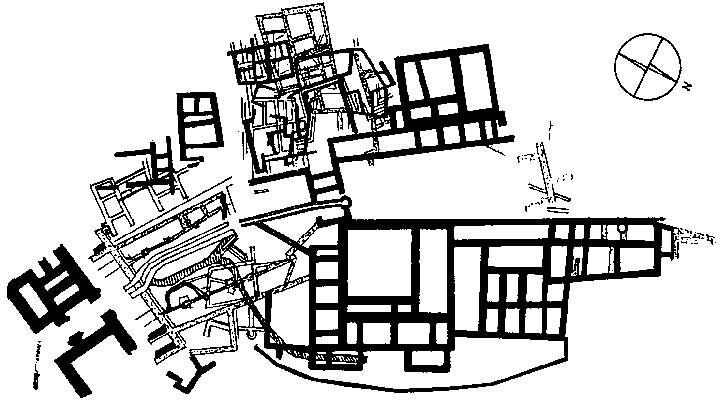ALACAHÖYÜK
During the summer, when the evenings are long, visitors to Boğazköy can easily stop
to see Alacahöyük on the return journey. Alacahöyük, with its still extant sphinx
gate, its interesting architectural remains and its local museum, is certainly an
archaeological site that is well worth seeing. We mention here that, in the caption to
plate 93 a, the Sphinx Gate, wrongly said to be at Yazılıkaya, should read Alacahöyük.

General plan of Alacahöyük
Alacahöyük was an important centre as far back as the Chalcolithic Age, that is, from
the 4th millennium on. Artifacts dating from this period and brought to light by Hamit
Koşay are in the Ankara Museum.
|
| The settlement reached the peak of its importance in the
Early Bronze Age. During Turkish excavations initiated thirty-five years ago by Atatürk,
archaeologists Remzi Oğuz Arık and Hamit Koşay
unearthed one of the most valuable artistic treasures of ancient times. These fascinating
works of gold, silver and bronze, including mysterious standards, now form an unrivalled
collection in the Ankara Museum (Pls. 84 b, 85, 87). The Hittite era,
too, witnessed glorious times in Alacahöyük. The remains which are still standing at the
present day (see plan above) belong to the Hittite Empire period (1450-1180 B. C.). The
sphinxes guarding the city gate can be seen on the spot, while the orthostats decorating
the city wall have been removed to the museum in Ankara. However, they are now replaced by
concrete casts. On the left side of the entrance facing east, we see from right to left on
the orthostats: 1 - King and Queen, worshipping a bull. 2 - Animals for the sacrifice. 3 -
Priests. 4 - jugglers (sword-swallower and a man climbing a ladder that stands up in the
air. 5 - Musicians. 6 - Unfinished relief, representing a bull and perhaps a chariot.
 On
the right side of the entrance is depicted, in sitting position, the Sun Goddess of
Arinna, the main female deity, worshipped by a number of adorants. The six male figures
depicted on the southward-facing wall inside the entrance, may also represent adorants,
venerating the Sun Goddess of Arinna, who is seen on the aforementioned orthostat of the
east front. The meaning of the scene with four persons, depicted on the northward facing
wall inside the entrance, is unknown. The inward-looking sides of the sphinx - blocks were
also adorned with reliefs. However, the relief of the southern sphinx-block is entirely
broken away; that of the northern sphinx-block is partly preserved; it represented a
female divinity supported by a double - headed eagle, gripping two hares in its talons.
From the standpoint of stylistic peculiarities, these reliefs belong to an artistic school
differing widely from that found at Boğazköy. Adjoining the east wall of the city is a
large building resembling a temple rather than a palace, with a courtyard, measuring 18-20
m. in width and 80 m. in length. The examples uncovered at Hattusa clearly indicate that
in Hittite cities the large structures served religious purposes, while the palaces were
comparatively small. An excellent model showing the superimposed cultural levels of
Alacahöyük is exhibited in the middle hall of the Ankara Archaeological Museum. On
the right side of the entrance is depicted, in sitting position, the Sun Goddess of
Arinna, the main female deity, worshipped by a number of adorants. The six male figures
depicted on the southward-facing wall inside the entrance, may also represent adorants,
venerating the Sun Goddess of Arinna, who is seen on the aforementioned orthostat of the
east front. The meaning of the scene with four persons, depicted on the northward facing
wall inside the entrance, is unknown. The inward-looking sides of the sphinx - blocks were
also adorned with reliefs. However, the relief of the southern sphinx-block is entirely
broken away; that of the northern sphinx-block is partly preserved; it represented a
female divinity supported by a double - headed eagle, gripping two hares in its talons.
From the standpoint of stylistic peculiarities, these reliefs belong to an artistic school
differing widely from that found at Boğazköy. Adjoining the east wall of the city is a
large building resembling a temple rather than a palace, with a courtyard, measuring 18-20
m. in width and 80 m. in length. The examples uncovered at Hattusa clearly indicate that
in Hittite cities the large structures served religious purposes, while the palaces were
comparatively small. An excellent model showing the superimposed cultural levels of
Alacahöyük is exhibited in the middle hall of the Ankara Archaeological Museum.
- Source:
- Ancient Civilizations and Ruins of Turkey,
Ekrem Akurgal
Istanbul 1973
|




